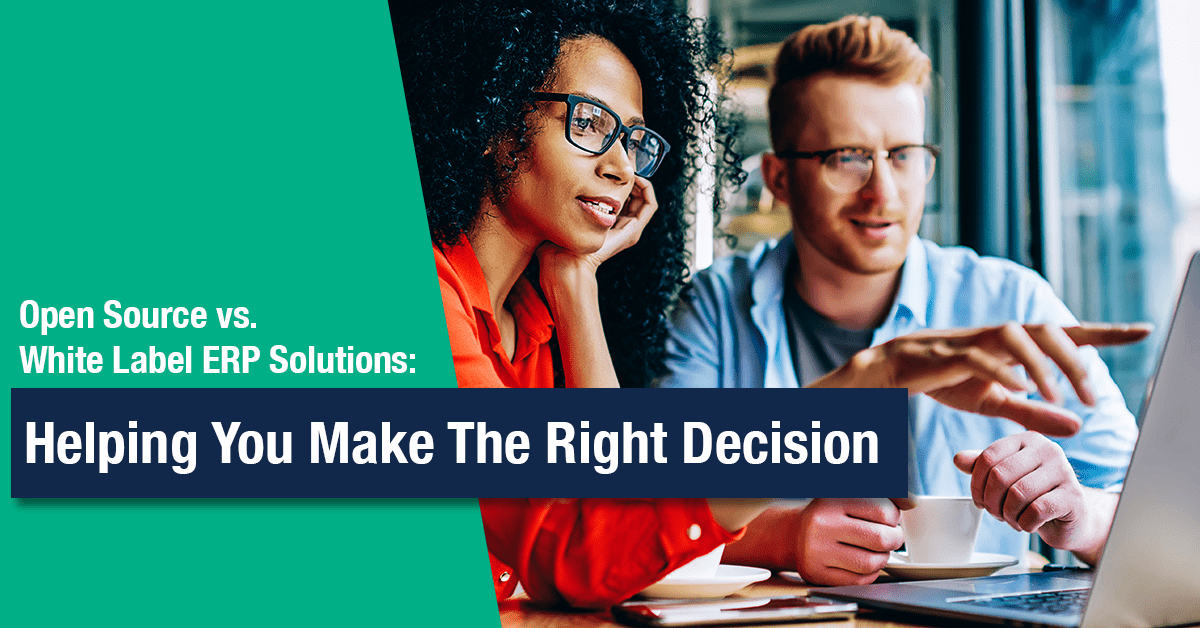
As an ERP software developer or reseller, there are two credible options for those wishing to jump start their ERP development journey in a bid to meet the burgeoning needs of customers: Open Source or White Label ERPs. So which should you choose? Knowing the benefits and consequences of each is crucial to shaping your own growth as a business.
Both can be effective at satisfying the demands of customers who want the latest software solutions. But only the White Label ERP route puts you in the driving seat ensuring you preserve the autonomy you need to grow and retain control of your business. To explain why, let’s put the two options side by side and see how they stand up to scrutiny.
What is Open Source?
Today, code is freely available for functions that might previously have been the preserve of proprietary software only. And there is no shortage of software developer teams ready to build a solution from Open Source code.
With an Open Source ERP solution, you take source code and modify it to suit the specific needs of your target customer or vertical. By implication, that means you need to have developer resources either in place or on contract to modify the code.
What is White Label?
White Label is a fully supported ERP solution that can often pack all the functionality and reliability of a proprietary ERP but without the brand presence of an SAP or Oracle behind it. As a vendor, you resell it to your customer base as your own.
Technology aficionados will be well aware that White Labelling is a standard practice that consumers are often completely unaware of. Huawei, for example, started out as a manufacturer of White Label handsets for various networks on its way to establishing itself as the world’s third-largest smartphone manufacturer.
Elsewhere, there’s every likelihood that the hard drive, processor or other components in your ‘exclusive’ laptop or desktop computer came from a variety of White Label sources.
Rather than run through a list of features for each, let’s compare them directly according to the most business-critical criteria.
How Much Does Each Cost?
Cost is a complex issue and recalls the common saying “Buy cheap, buy twice”. Open Source software has a very attractive entry point – there are no installation or license fees and minimal capital investment required. White Label ERP, on the other hand, incurs the cost of purchase or licensing.
However, no ERP – even an off-the-shelf solution – is a one-time purchase. The following rolling costs have to be factored in:
i) Customisation cost
It is extremely likely that Open Source software will be fit for purpose, in general terms, from the outset. By nature, Open Source software is broad and generic in scope. In order for it to represent any competitive value to the customer, there has to be some degree of customization.
That means you will have to allocate developer resources, whether they are in-house or outsourced. For a small size custom software development project, those costs can range anywhere from $10,000 to $500,000.
With a White Label ERP, you can start with an industry-specific solution that offers targeted functionality. Should you then need to customize or modify as the business evolves, a rules-based architecture typically makes it easy to modify. Resellers typically have three options for customization: partner with the source code owners; use in-house developer resources; or buy the add-ons from partners who already have a working solution. Developer input will be necessary to add on functionality and features that plug into the core solution, but it is with the expectation that these costs will translate into extra revenue for the reseller and extra value for the customer. For projects that do require development assistance, white label ERP vendors often include partner development as part of the agreement, meaning you don’t have to hire in a team of developers or if you have a development team they can work directly with the source code owners to facilitate code changes.
ii) Testing cost
Without clearly defined authorship, there is no guarantee that an Open Source solution works reliably. Bugs and security issues are an inherent risk. Yes, they do tend to be identified early and patched by community groups, but when you resell an ERP to a customer, it’s not good for your business if the software comes with a lengthy appendix of steps to take just to make it work as promised.
With a White Label ERP, on the other hand, there will have been rigorous R&D and testing, to the same standard as proprietary ERPs. It’s been tested against the demands of your vertical and judged to be up to the task as a technically mature solution.
iii) Support cost
Open Source software often comes with a community following. Yes, it’s engaging and responsive, but that’s hardly a template for serious long-term business. What if the community ceases to grow? Who will then take ownership of updates and patches? This isn’t something that can be managed on an ad hoc basis.
When nobody is responsible and nobody liable, if there is a software issue, it’s your responsibility to address it, which will mean bringing in potentially expensive software support, perhaps in an emergency.
With White Label ERP, at least you have a number to call, and in theory, you should have a significant grace period before you need to address the issue of support. A White Label ERP will have gone through years of testing, so it’s reliable from the start. You get more uptime, better functionality, and regular updates from the vendor to keep it running smoothly.
iv) Training cost
With an Open Source solution, the vendor has to assume all the costs of learning, adapting, and maintaining the solution, then creating a toolkit from scratch to show customers how to use it. If there are in-house developers available, that cost will be factored in, but it’s still an ongoing cost.
White Label ERP still presents a training cost – your team will need to learn the ERP solution inside and out in order to anticipate customer questions and resolve issues. But the focus, in this case, is on the functionality and features, rather than what’s under the bonnet. There’s a closer relationship to the customer requirements when it comes to training. The white label ERP vendor is also likely to have a library of training manuals, videos, etc. for you to brand and make your own.
These then are the explicit cost comparisons between Open Source and White Label. In simple terms, Open Source offers low investment but high running costs, whereas White Label requires initial CapEx or licensing, but fewer nasty surprises thereafter.
Perhaps a useful analogy would be buying a car from a dealer on finance (White Label) versus buying it from a private seller (Open Source). With the latter option, you may come up lucky – or you may find yourself stuck at the side of the road with somewhere to be, waiting for a recovery vehicle to ride to the expensive rescue.
Let’s stretch the analogy further. The value of a car isn’t just how much it costs to run. If it were, everyone would still be driving a Model T. Instead, it’s what a car says about you as an owner. In the same way, let’s look at what your ERP solution says about you as a business.
Associated Value of an ERP Solution
To surprise and delight your customers with an Open Source ERP takes some serious investment. Open Source software is by its very nature generic, often with a big gap between core functionality and the specific needs and business requirements of your target customers. If you want to resell a solution that is competitive, you have to invest heavily in the developer support to finesse it.
That’s not the case with a White Label ERP. In fact, your business actually benefits from the association with a respected, highly rated product that carries your name. And you can move fast. It’s off the shelf, so you can respond quickly to what your customers want next. As far as your customers are concerned, you’ve just released a new product.
If you’re not allocating resources to the nuts and bolts of building a tailored software solution, what could you be doing? As an ambitious business, you can be using that time to build customer relations, grow your market and define a yet more elaborate range of products and services, with the ultimate goal of maximizing customer lifetime value. Or if you are focused on developing MRP software or a niche application the White Label ERP solution can work to complement your offering so you provide a 360-degree solution to your customers. In this respect, the White Label solution allows you to build your brand and focus your energies on value-adding activities.
That does come with a caveat. You’ll need to invest in marketing materials and training toolkits to onboard customers seamlessly and enrich their experience. There’s a relationship to nourish, not just a sale to be made.
In some cases, you’ll also have to overcome customer resistance to your lack of experience or pedigree in the sector with some powerful testimonials, especially if you’re offering a solution that positions itself directly with an off-the-shelf ERP solution.
The Customer Perspective on ERP
We’ve focused so far on what it takes to get to the starting line, with the early conclusion that without considerable in-house developer resources, Open Source ERP represents a risk compared to White Label. But these aren’t considerations for your customer. All your customer wants is a best-in-class solution for their business needs. That might include:
i) Ease of integrating cloud-based devices, mobile apps, and IoT securely, whilst preserving the option of hosting on-premise, cloud or hybrid.
ii) A solution that goes beyond mission-critical functions covered by off-the-shelf ERP platforms. They want agile, user-based, intelligent ERP solutions that facilitate decision making and enable action.
iii) Future-proofing ERP solutions that support 5G, remote working, AI and Machine Learning.
iv) An eCommerce solution that rises to the challenge of online, 24/7 direct to customer business models.
v) Freedom to adapt to local or vertical requirements by seamlessly integrating 3rd party niche platforms – and the resources and information to find the best match for their business easily.
With a White Label ERP solution, these goals can be shared. The vendor can sell a tailored ERP solution that can be extended, customized and replaced autonomously, without the need to return to the vendor regularly for support. Or the vendor can absorb the entire or elements of the white label ERP application into their own platform. A characteristic of modern White Label ERP is that it’s easily configurable and doesn’t require substantial dealings with the software provider to satisfy your customers’ requirements.
The GenetiQ Solution
The distinguishing feature of the GenetiQ ERP white label solution is that its tried and trusted framework is built to be built upon and offers the security of ongoing vendor support. See the full list of benefits here.




